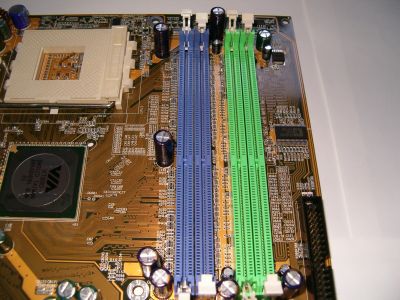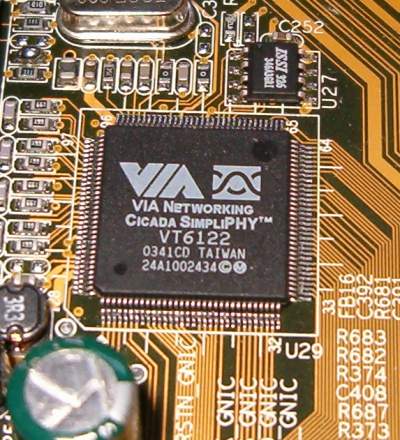VIA VT5805B Reference Board
The VT5805B is VIA's slightly odd KT880 reference board. Click the picture for a bigger version.
Given that it's a reference design and won't be copied by any manufacturer that produces a KT880 board, I won't bother discussing layout like I usually do, but we'll take a look at what the board has on-board. VIA traditionally packs its reference boards with everything it has to offer.

It's a dual-channel motherboard so it's nice to see all four slots present, rather than the crippled three slots that you'll usually see on an nForce2 dual-channel board. The memory controllers will take 2GB each, so you've got 4GB maximum with 1GB DIMMs, providing you get all four slots on shipping board designs. You use slots 1+3 or 2+4 for dual-channel operation, 1+3 was the tested and benchmarked setup.
The northbridge heatsink is reminiscent of what EPoX have used on recent Pentium 4 motherboards. Big, aluminium, thankfully fanless, the heatsink cools the following chip very well.

I've inverted the image so you can see the inscription on the top of the metal cap since it didn't show up too well normally.
The southbridge is the usual bare bridge that you'll see on a wide range of motherboards now. The VT6421 is the augmented Serial ATA controller that replaces the second PATA channel from the VT8237. The connector for the channel is on the board though, the eagle eyed among you will have spotted it. Only one port is hung from the ASIC though, not two. Strange, but that's what you get from a VIA reference board.

The VT6122 is the Velocity LOM (LAN-on-motherboard) chip, giving the board Gigabit Ethernet capabilities, sat on the regular 33MHz secondary bus. The VT1720 is an Envy24PT. 24-bit resolution with 96KHz sample rate, it's an eight-channel solution that's usually paired with a VT1616 Six-Trac and a hanging high-end DAC for the front stereo ports.
Lastly, a quick picture of the ATX I/O ports.










